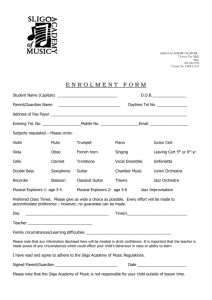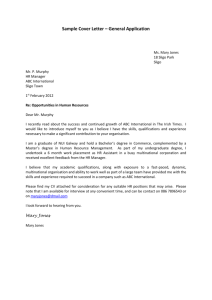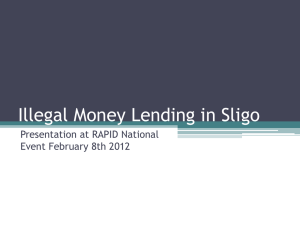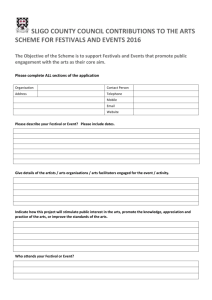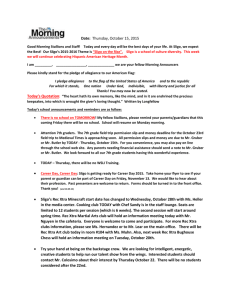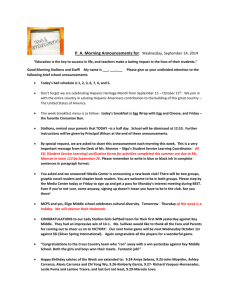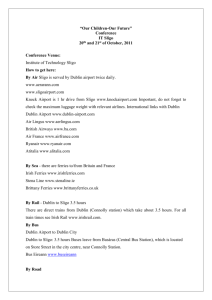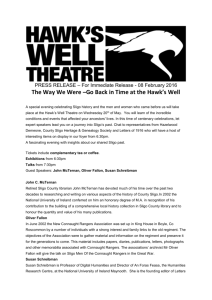Computer Applications
advertisement
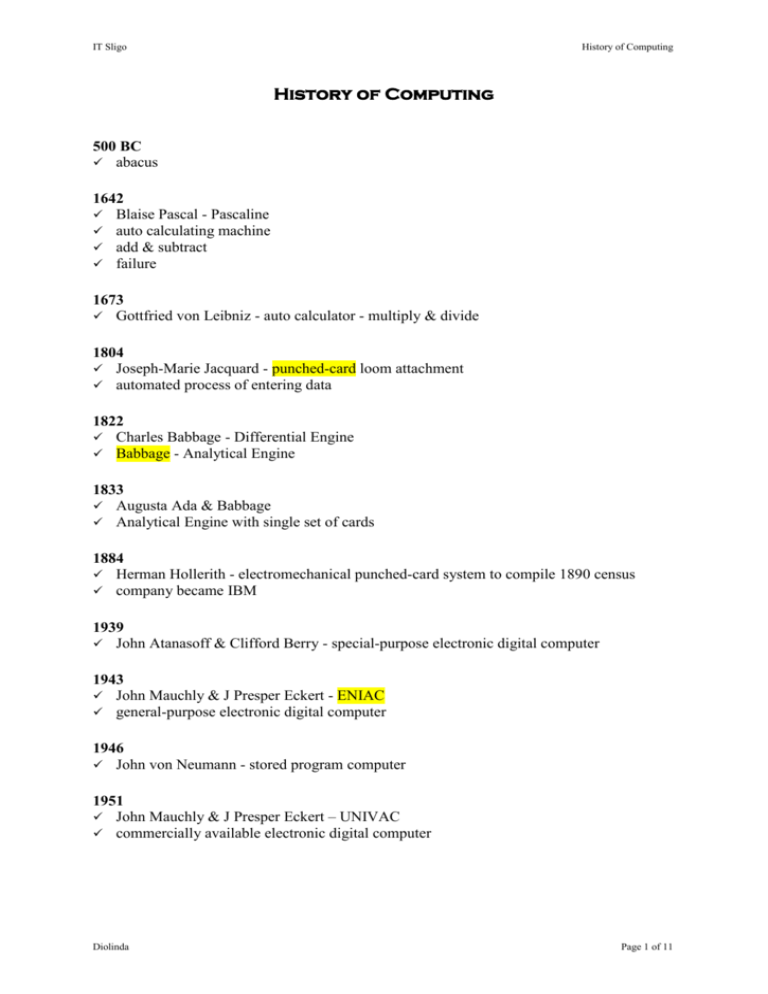
IT Sligo History of Computing History of Computing 500 BC abacus 1642 Blaise Pascal - Pascaline auto calculating machine add & subtract failure 1673 Gottfried von Leibniz - auto calculator - multiply & divide 1804 Joseph-Marie Jacquard - punched-card loom attachment automated process of entering data 1822 Charles Babbage - Differential Engine Babbage - Analytical Engine 1833 Augusta Ada & Babbage Analytical Engine with single set of cards 1884 Herman Hollerith - electromechanical punched-card system to compile 1890 census company became IBM 1939 John Atanasoff & Clifford Berry - special-purpose electronic digital computer 1943 John Mauchly & J Presper Eckert - ENIAC general-purpose electronic digital computer 1946 John von Neumann - stored program computer 1951 John Mauchly & J Presper Eckert – UNIVAC commercially available electronic digital computer Diolinda Page 1 of 11 IT Sligo History of Computing 1957 IBM - Fortran 1964 Thomas Kurtz & John Kemeny - BASIC 1964 Control Data Corporation - first supercomputer – CDC 6600 1965 DEC - PDP-8 commercially available minicomputer 1967 MIT - MacHack – first program to play chess 1968 Edsger Dijsktra - structured programming 1971 Intel - first microprocessor chip 1971 DENDRAL - first expert system 1974 Intel - microprocessor later used in IBM computers 1975 Bill Gates & Paul Allen - Microsoft Corporation 1977 Stephen Wozniak & Stephen Jobs – Apple II computer 1979 VisiCalc - first commercial spreadsheet 1980 Ashton-Tate – dBase - most popular DBMS for PCs 1980 WordStar - first word processing package Diolinda Page 2 of 11 IT Sligo History of Computing 1981 IBM PC 1982 WordPerfect - word processing package 1982 Compaq Inc founded - competitor to IBM 1982 Hayes - 300 bps smart modem 1982 breakup of AT&T - companies create own WANs 1983 Lotus founded - spreadsheet software 1983 IBM PC Jr - home market 1984 IBM - 80286 1984 Apple unveiled Macintosh 1984 Hewlett-Packard - laser jet printer 1985 Microsoft - first GUI 1985 80386 chip 1985 DTP Aldus Pagemaker 1986 Compaq - 80386 1987 IBM & Microsoft - OS/2 1987 IBM - PS/2 Diolinda Page 3 of 11 IT Sligo History of Computing 1988 Intel - million-transistor microprocessor 1988 smaller notebook PC 1989 multimedia touted but took years to catch on 1990 80486 1990 Microsoft - Windows for DOS IBM - OS/2 1991 IBM & Apple - share technology 1992 80586 1992 CD-ROM 1992 object-oriented programming 1992 multimedia standards set 1993 Pentium microprocessor 1993 id software – Doom - shooter-style game 1993 Eric Bina & Marc Andreessen - Mosaic Diolinda Page 4 of 11 IT Sligo History of Computing 1994 Mosaic available for Mac OS & Windows 1994 Netscape founded 1994 Jerry Yang & David Filo - Yahoo 1994 Iomega Zip disk 1995 Netscape valued at $2 billion 1996 Intel - 200 MHz Pentium processor 1996 Microsoft - Windows NT 4.0 Microsoft - Windows CE for hand-held 1996 PDA becomes available 1996 IBM - OS/2 Warp 4 1996 CD-RW 1996 IBM - first web shop 1996 Lycos, Excite, Yahoo went public 1996 Jeff Skoll & Pierre Omidyar - eBay 1996 Microsoft - IE Diolinda Page 5 of 11 IT Sligo History of Computing 1997 J Haaften (Ericsson) - Bluetooth 1997 Nokia - “smart messaging” 1997 IBM - Deep Blue super computer 1997 Amazon.com goes public 1997 Microsoft buys Web TV Networks 1998 first affordable digital cameras 1998 Apple Inc - iMac 1998 US government privatize registration of URLs 1998 Bill Clinton – signed Digital Millennium Copyright Act 1998 AOL bought Netscape 1998 Larry Page & Sergey Brin - Google 1999 ICL (Electrolux) - Kitchen Computer 1999 palmtop computers with colour displays 1999 millenium bug taken seriously 1999 prices of PCs plummet Diolinda Page 6 of 11 IT Sligo History of Computing 2000 serious millennium bugs not reported 2000 Bill Gates resigned - Steve Ballmer took over 2000 AMD Athlon - 1000 MHz or GHz barrier broken 2000 Intel – Pentium III 1000 MHz 2000 cyber terrorists brought some major sites down (eBay, Amazon, etc) 2000 federal judge orders MS to breakup 2001 Wikipedia founded 2001 MS - Windows 2000 2001 MS - Windows ME 2001 Internet stock bubble burst 2001 judge reverses decision to split up Microsoft 2001 injunction against Napster to begin blocking copyrighted music 2001 PCs with CPUs in excess of 1.4 GHz come on market 2001 MS - Windows XP 2001 approx 460 million people connected to Internet 2001 Apple - iPod Diolinda Page 7 of 11 IT Sligo History of Computing 2002 Internet’s main language is English 2002 NEC - Earth Simulator System - world’s fastest supercomputer 2003 Mozilla founded 2003 Casio Computer Co – “micro reformer” for laptop 2003 European Central Bank - smallest integrated circuit into notes to prevent counterfeiting 2003 spam serious on Web 2004 Google - largest index on Web 2004 Mydoom virus 2004 estimated 650 million PCs in use around world 2004 first mobile phone virus (Cabir) appeared 2004 Google - “Google Print” - to produce online digital library 2005 Google indexes 8 billion pages 2005 MS browser dips below 90% market share 2005 MIT - $100 laptop to revolutionise education of children 2006 spam - mobile phones & PDAs infected 2006 Yahoo & AOL - email stamp - used to dam flooding of spam Diolinda Page 8 of 11 IT Sligo History of Computing 2007 MS Windows Vista updated GUI & visual style, improved searching, new multimedia creation tools 2007 Apple Mac OS X 2008 IT Sligo represents Ireland at global finals of MS Imagine Cup 2008 ParkIT - real time parking information at ITSligo central database, sat-nav or mobile phone to request parking space 2008 sub-notebook PCs / mini-PC / netbook) Aver AspireOne or Asus EEE PC affordable & more flexible 8 or 10 –inch screen, €300 Windows XP or Linux word processing, email, spreadsheets, surf Internet via wireless broadband 2008 eLearning company announce 450 new jobs in Dublin over next 5 years new R&D centre will drive innovation Diolinda Page 9 of 11 IT Sligo History of Computing 2009 Microsoft opens "mega" data centre in Dublin - new epicenter of MS’s cloud computing strategy for next decade data centre - also called server farm - facility used to house computer systems & components - can occupy 1 room, several floors or entire building - servers stored in racks in long corridors - 50% more energy efficient than those built 3 years ago cloud computing - also known as demand computing or utility computing - where data, software applications or computer processing power are detached from physical location & accessed from "cloud" of online resources - computing capacity may now be obtained by plugging-in to online resources in same manner as connection is made to national grid to obtain electrical power - consists of reliable services delivered through data centres - users do not physically possess storage of their data 2009 O2 exclusive carrier in Ireland of new Palm Pre smart phone (in October) smart phone - mobile phone offering advanced capabilities - often with PC-like functionality Palm Pre - also known as the "Castle" - multimedia smart phone designed & marketed by Palm - multi-touch screen & sliding keyboard - launched in June 2009 - uses Linux OS (webOS) - functions as a camera phone, portable media player, GPS navigator, Internet client 2010 Android phone - alternative to iPhone - Google-backed OS for mobile phones - users can create their own interfaces Project Natal - for XBOX 360 - gaming with no controller at all - user movements & voice control game Diolinda Page 10 of 11 IT Sligo History of Computing 2010 Electric Eye - MIT researchers developing microchip that will enable blind person to recognize faces & navigate room without assistance - helps blind to regain partial eyesight - implanted into eyeball - user wears special glasses fitted with small camera Sixth Sense - wearable interface - pocket projector, mirror & camera which allows user to interact with objects - user can take picture by framing scenery with hands - user can hold up object in shop & find out all relevant information about it 2011 Brain-Like Computing - simultaneous information processing (by CPU) & storage (in memory) using phasechange materials makes computers faster & more energy-efficient also makes them more like biological systems (humans) shows that artificial systems could learn & process information like human brains 4-D film - entertainment presentation system combining 3-D film with physical effects theatre - these effects occur in sync with film - example "Spy Kids 4" Diolinda Page 11 of 11
